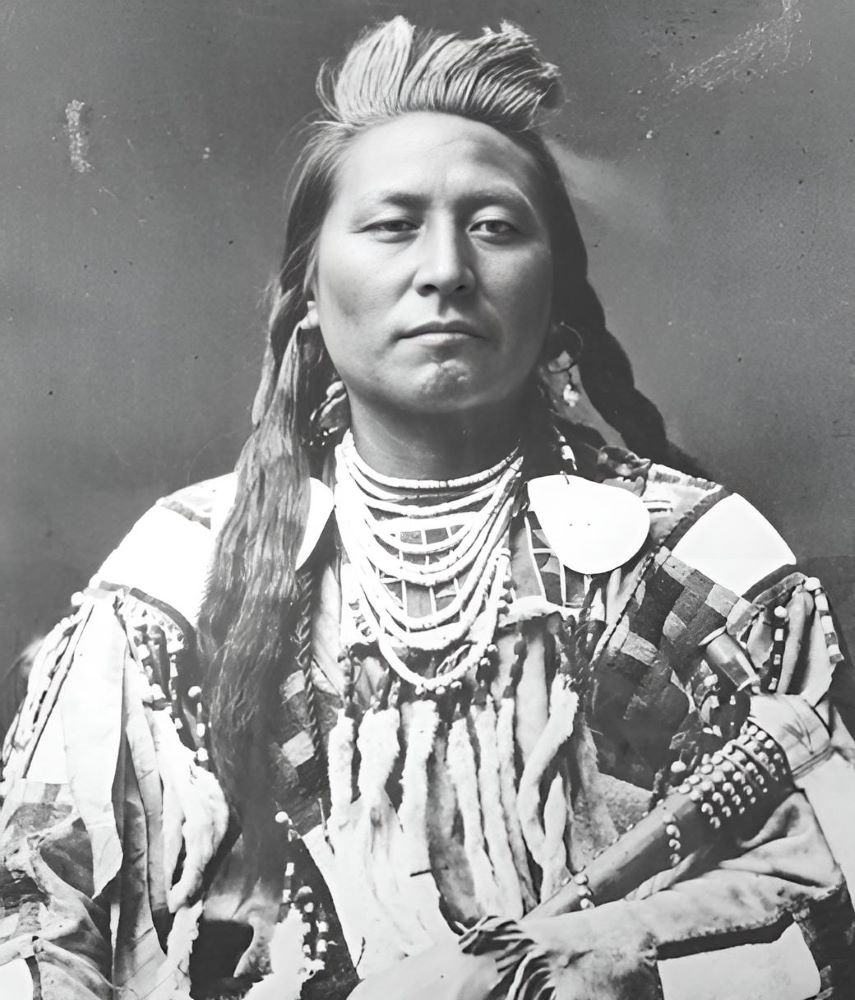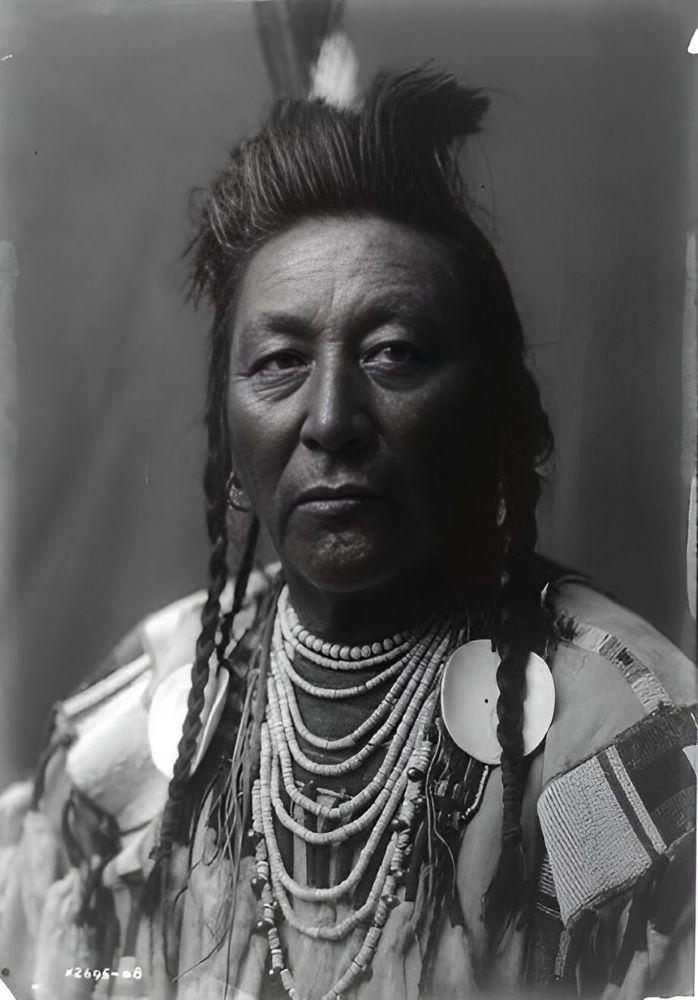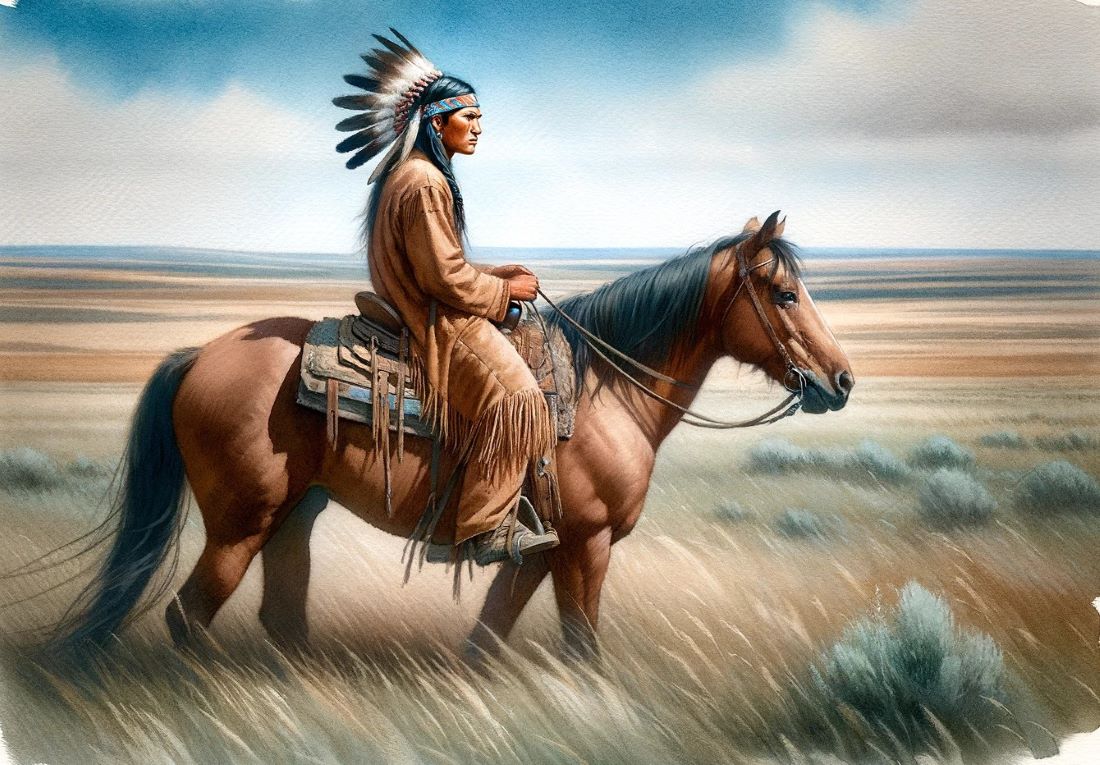Plenty Coups (1848–1932), whose Crow name (Aleek-chea-ahoosh) signified “Many Achievements,” emerged as a pivotal figure in Native American history, particularly during the tumultuous era of the Plains wars. As the principal chief of the Crow people during these critical times, he led with a strategic vision that was both pragmatic and forward-looking. Notably, Plenty Coups advocated for cooperation with the U.S. Army, a move that involved the Crow people providing crucial support in the military campaigns against other Native tribes, including the Cheyennes, Sioux, and Arapahoes, especially after the pivotal Battle of the Little Bighorn in 1876. This alliance, though controversial, showcased Plenty Coups’ commitment to securing a place for the Crow people within a rapidly changing world, a testament to his leadership and the nuanced legacy he left behind.
Plenty Coups – From Loss to Leadership
Plenty Coups’ early years were marked by a blend of personal tragedy and a sense of destiny that propelled him towards leadership among the Crow people. From a tender age, he was recognized by his community for his potential, receiving an unusual amount of attention and grooming for chieftainship. This period of his life took a pivotal turn when he was just nine years old, as tragedy struck with the killing of one of his brothers by the Sioux. This incident not only deepened the historic animosity between the Crows and the Sioux but also marked the beginning of Plenty Coups’ lifelong commitment to defending his people and their territory. The Sioux’s earlier aggression had forced the Crows westward into the Little Bighorn country, an area rich with buffalo but also a point of contention with their enemies, setting the stage for future conflicts.

Plenty Coups’ path was further shaped by vivid dreams he experienced, which foretold the disappearance of buffalo from the Plains, replaced by the white man’s cattle. Sharing these visions with the Crow spiritual leaders, they discerned a message of adaptation and cooperation with the encroaching settlers as a means to mitigate the impact on their way of life. By the age of fifteen, Plenty Coups had already demonstrated his bravery and skill in battle, taking his first scalp and capturing horses. Yet, he was mindful of the wisdom from his dreams and the elders, choosing a path that eventually led to collaboration with the United States military. His decision to align with General George Crook in 1876, providing 135 Crow warriors as scouts, was a strategic move during a critical time. Despite his concerns over Crook’s readiness to face Crazy Horse and the Lakotas, Plenty Coups’ insight and leadership were evident. This alliance, although controversial, underscored a pivotal moment not only in the Battle of the Little Bighorn but also in the broader narrative of Native American resistance and accommodation in the face of U.S. expansion.
Plenty Coups – Shaping a New Future
After the monumental Battle of the Little Bighorn in 1876, Plenty Coups emerged as a visionary leader, guiding the Crow people through a period of significant transformation. His strategic alliance with the U.S. Army proved instrumental in the ensuing conflicts, as Crow warriors played a crucial role in the subjugation of the Cheyennes and Sioux. They aided in the pursuit of Sitting Bull into Canada, contributed to the defeat of the northern Cheyennes, and were part of the forces leading to the surrender of Crazy Horse. Under Plenty Coups’ leadership, the Crows not only secured a pivotal position alongside the U.S. military but also began to navigate the profound changes reshaping the Plains.

Recognizing the inevitability of change, Plenty Coups championed a vision for the future that included adopting farming and ranching as new means of sustenance, marking a significant departure from the nomadic lifestyle that had defined the Crow people for generations. He led by example, exchanging his teepee for a log farmhouse and opening a general store to ensure the Crows had access to trade goods at fair prices. His repeated journeys to Washington, D.C., after 1880 were strategic moves to secure trade and aid for his people, showcasing his acumen in both leadership and business dealings. Through these actions, Plenty Coups demonstrated a remarkable ability to adapt and guide his people through the challenges of an era marked by profound change and uncertainty.
Legacy of a Visionary
Plenty Coups stands as a symbol of adaptability and foresight in a period of great upheaval for the Crow people. His leadership, characterized by a blend of strategic alliances and innovative adaptations to settler society, was aimed at ensuring the survival and prosperity of his people in the face of encroaching U.S. expansion. His actions, particularly his push for the Crows to engage in farming and ranching, reflect a profound understanding of the need for change. Yet, through it all, Plenty Coups remained deeply committed to justice and the integrity of his people, as highlighted by his critique of the U.S. government’s double standards:
“They spoke very loudly when they said their laws were made for everybody; but we soon learned that although they expected the Crows to keep them, they thought nothing of breaking them themselves.”
Plenty Coups’ legacy is one of resilience and wisdom, leaving an indelible mark on both his people and the broader narrative of Native American history. His passing on March 3, 1932, marked the end of an era but also cemented his status as a visionary leader whose life was dedicated to navigating the challenges posed by a rapidly changing world. His poignant observations on the inconsistencies of U.S. law enforcement underscore a timeless message about the importance of fairness and the struggle for rights. Plenty Coups’ life story is a testament to the power of leadership that is rooted in the values of adaptability, foresight, and an unwavering commitment to justice.
Historical Challenge: Can You Conquer the Past?
Answer more than 18 questions correctly, and you will win a copy of History Chronicles Magazine Vol 1! Take our interactive history quiz now and put your knowledge to the test!

